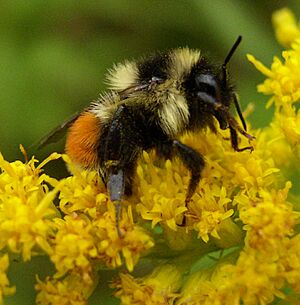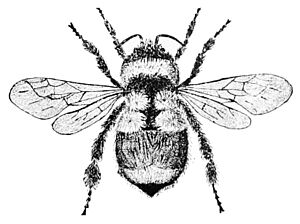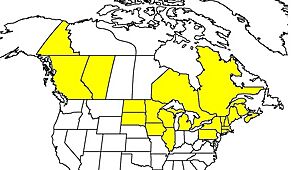Orange-belted bumblebee facts for kids
Quick facts for kids Orange-belted bumblebee |
|
|---|---|
 |
|
| Conservation status | |
| Scientific classification | |
| Genus: |
Bombus
|
| Species: |
ternarius
|
The Bombus ternarius, also known as the orange-belted bumblebee or tricolored bumblebee, is a colorful bee. It has yellow, orange, and black stripes. This bumblebee lives in social groups and builds its nests underground. Its colony lasts for only one season.
You can find the orange-belted bumblebee across the northeastern United States and much of Canada. These bees collect food from plants like Rubus (like raspberries), goldenrods, Vaccinium (like blueberries), and milkweeds. Like other bumblebees, Bombus ternarius colonies have a queen bee who lays eggs. Many worker bees help by finding food, taking care of the young, and keeping the nest clean.
Contents
What Do Orange-Belted Bumblebees Look Like?
B. ternarius is a small, thin bumblebee.
- The queen is about 17 to 19 millimeters (about 0.7 inches) long. Her body is about 8.5 to 9 millimeters wide.
- The workers are smaller, about 8 to 13 millimeters (about 0.3 to 0.5 inches) long.
- The drones (males) are 9.5 to 13 millimeters (about 0.4 to 0.5 inches) long.
Both workers and drones have bodies about 4.5 to 5.5 millimeters wide.
Queens and workers have black heads with a few light yellow hairs. Their bodies are yellow at the front and back. The middle part of their body (segments 2 and 3) is orange, and the very end is black. Queens and workers look very similar. The main difference is that young queens have a lot of fat stored in their bodies. Workers have very little fat, which leaves space for their honey stomach. This is a special part where they store nectar when they are out collecting food.
Drones have yellow heads with a few black hairs. Their body colors are like the females, but the last parts of their body are yellow on the sides. Drones also have longer fur than the females.
Another bumblebee, B. huntii, looks almost the same as B. ternarius. However, B. huntii has mostly yellow hairs on its face, while B. ternarius has black ones.
Where Do Orange-Belted Bumblebees Live?
B. ternarius mostly lives in the northern parts of the US and a lot of Canada. You can find them from the Yukon to Newfoundland and Labrador and British Columbia. In the United States, they live from New York and Pennsylvania to Michigan, Washington, Wyoming, Utah, and Montana. These bumblebees do best in cooler, northern climates. They are rarely found farther south.
Like most bumblebees, B. ternarius colonies are seasonal. This means the queen wakes up from hibernation in late April. She then starts a new colony. The worker bumblebees fly from May to October. By mid-autumn, the whole colony dies, except for the new queens who will hibernate. Then, the cycle starts again the next spring.
Life Cycle and Nests
In late April, the queen bumblebee wakes up from her winter sleep. She has been hiding under loose soil or leaves. She then starts looking for a good place to build a nest. Bombus ternarius likes to nest underground in small, shallow spots. These can be old rodent burrows or natural cracks in the ground.
Once she finds a good spot, the queen flies around to collect pollen and nectar. This food will help her future babies grow. Next, she makes a special waxy layer and a small area where she lays her fertilized eggs. These first eggs will become the new workers. The queen sits on her eggs, touching them with her body. This helps her warm the eggs with her own body heat. This warming helps the eggs grow faster.
After about a month, the eggs hatch and go through four stages: egg, larva, pupa, and then adult worker. Warming the eggs takes a lot of energy for the queen. She needs to visit many flowers to get enough sugar for this. When she leaves the nest, the eggs cool down quickly. So, it's very important that there are many good flowers nearby for her to find food.
The new workers take over the job of finding food and making the nest bigger. They also help warm the eggs and larvae. B. ternarius nests usually have fewer than 200 bees.
In late summer, the queen starts laying eggs that are not fertilized. These eggs grow into male drones, whose job is to mate. Later, the queen lays fertilized eggs again. These eggs will become new female queens. These new queens collect food and build up fat for winter. They also mate with the male drones. The new queens fill their honey stomach with honey to help them survive winter. The rest of the colony, including the old queen, dies in mid-autumn.
How Bumblebees Reproduce
Male drones have one main job: to reproduce. They fly around in a pattern and leave a special scent, called a pheromone, on things like tree trunks, rocks, or posts. This scent helps attract the new queens. A new queen follows the scent trail and mates with a male.
Bumblebees usually mate on the ground or in plants.
For all bees, wasps, and ants, whether an individual becomes male or female depends on its chromosomes. Fertilized eggs get two sets of chromosomes, one from each parent. These eggs grow into females. Unfertilized eggs only have one set of chromosomes from the mother. These eggs grow into males (drones). The queen decides whether to fertilize an egg or not. This system is called haplodiploidy.
How Bumblebees Become Queens or Workers
All fertilized eggs can become either a worker or a queen. It doesn't matter when they are laid. Some scientists think that bumblebees can decide if a larva becomes a worker or a queen by feeding it a special diet. Larvae are fed a mix of pollen, nectar, and proteins made by adult bees. This mix is given to the larvae in small drops.
However, it seems unlikely that the food itself is the main reason for caste. Nurse bees often feed all types of larvae (queens, workers, and males) from the same food supply.
A better idea is that the current queen makes a special pheromone (a chemical scent). Larvae are sensitive to this pheromone when they are between two and five days old. If the pheromone is present, the larva will become a worker. If the pheromone is not there, the larva will become a queen. This pheromone has not been found yet, but there is strong evidence it exists. It seems the pheromone is passed directly from bee to bee, not through the air.
What Bumblebees Eat
B. ternarius visits many plants for food. These include Rubus (like blackberries), goldenrods, Vaccinium (like cranberries), and milkweeds. Bumblebees eat and collect both nectar and pollen. Nectar is stored in a special pouch inside the bee called the crop. Pollen sticks to the hairs on the bumblebee's body. The bee pushes the pollen to its back legs, where it collects in a "pollen basket."
Back at the nest, the bee spits out the nectar from its crop. It mixes with special chemicals (enzymes) and dries in the air. As it dries, it turns into honey. Pollen is mixed with nectar and honey to make a food rich in protein for the larvae.
Before western honey bees were brought to North America, bumblebees were the only bees that made honey here. However, they only make small amounts of it.
Bumblebee Behavior
Queen and worker bumblebees can sting. Unlike honey bees, a bumblebee's stinger does not have barbs. This means a bumblebee can sting many times without dying. B. ternarius is not usually aggressive. But it will sting if its nest is in danger or if it feels threatened.
Living in a Colony (Eusociality)
B. ternarius, like other bumblebees, lives in eusocial colonies. This means the bees in the group act like one big "superorganism." This social way of life might have started because young bees stayed in the nest to help raise their mother's new babies.
The mostly sterile (cannot have babies) worker bees find food and take care of the colony. The queen's job is to lay eggs and make new generations of workers. Towards the end of the colony's life, workers might push the queen, eat her eggs, and try to lay their own eggs. Workers are not completely sterile; they can lay eggs, but these eggs always become males. The queen usually fights back by being aggressive towards the workers and trying to eat their eggs. But sometimes, the queen's efforts are not enough, and the aggressive workers might even kill her.
How Bumblebees Find Food (Foraging)
Flying takes a lot of energy for bumblebees. They use energy even faster than hummingbirds! So, it's very important for them to find food efficiently. If they don't, they might use more energy flying than they get from the food. Pollen has a lot of protein, which is needed for flying. But it's harder to collect than nectar.
Bumblebees learn as they go. New pollen collectors often come back lighter from their first few trips. This means they are getting better at finding food. Older and more experienced workers tend to collect pollen. This helps the colony because less experienced bees waste less energy, and more pollen is brought back to the nest.
We don't know exactly how far bumblebees fly to find food. On average, they can fly up to 6 kilometers (about 3.7 miles). If food is scarce, they might fly as far as 20 kilometers (about 12 miles). You might think bees would visit the closest food patches most often. But this would mean less food is left there. So, workers might fly farther from the nest to find more food. Some people think bees fly farther to avoid predators near the nest, but this idea is not often supported.
A bumblebee often does not fill its nectar crop all the way when it's collecting food. This is because the weight of the nectar adds to the energy needed for flying. A bee carrying a lot of nectar uses much more energy. Sometimes, a full crop might make the bee burn more energy than the nectar brings back.
Who Does What (Division of Labor)
The queen's main job is to lay eggs and make sure the colony has new workers. The worker bumblebees do most of the other jobs. These include finding food, keeping the nest clean, and taking care of the young bees.
Younger workers usually start by working inside the nest. They spend most of their time there. Bumblebees make wax from the underside of their bodies. A bee can make wax starting around its second day as an adult, but this ability goes down after the first week. Since wax is only needed inside the nest, young workers are good at jobs like nest maintenance.
As bumblebees get older, they are more likely to switch from working inside the nest to finding food outside. Also, newer food collectors usually gather nectar. As they get older, they tend to switch to collecting pollen. For a long time, people noticed that food collectors were generally larger than bees that worked inside the nest. This is because larger workers tend to start finding food earlier than smaller workers. The very smallest workers never switch to finding food and stay inside the nest their whole lives.
What Does the Name Mean?
Bombus ternarius was first named by Thomas Say in 1837. The word Bombus is Latin for "buzzing." This refers to the sound these insects make. The name ternarius means "number three." This refers to the bumblebee's three main colors: yellow, orange, and black.
See also
- List of bumblebee species






